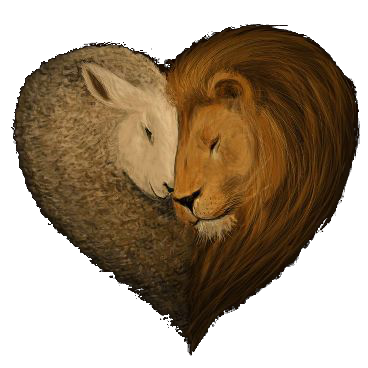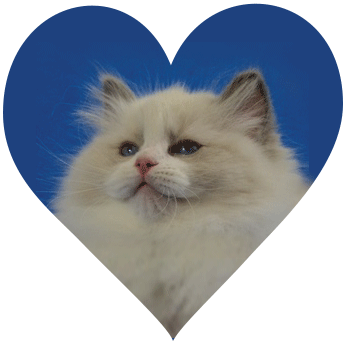|
C.C.A.
The Canadian Cat Association
L'Association Feline Canadienne
|
|

|
|
Point Distribution
|
|
Item
|
Points
|
|
Body Type & Confirmation
|
30
|
|
Body
|
20
|
|
Legs & Feet
|
5
|
|
Tail
|
5
|
|
Head Type
|
30
|
|
Skull
|
20
|
|
Ears
|
5
|
|
Eyes
|
5
|
|
Coat Texture & Length
|
10
|
|
Colour
|
20
|
|
Condition
|
10
|
|
|
GENERAL
The
Ragdoll is a hybrid breed resulting from mating of a White Persian and
a Seal Point Birman. The resulting progeny was then mated to a Sable
Burmese, thereby establishing the original lines in the 1960. The breed
is an exceptionally large, heavy, firm and muscular cat. They have
large, oval, blue eyes and medium size ears which are set high on a
modified, wedge shape head. The nose is twice as long as it is wide
with a gentle break. Overall, the cat is broad at the chest and
hindquarters. Its high hindquarters make the back appear to tilt
forward slightly. Large, round and tufted paws balance heavy-boned,
medium-length legs. The coat is medium to long.
|
|
I - BODY TYPE/CONFORMATION (30)
BODY (20) - The neck is strong, heavy set and
short. Chest full and well expanded, giving the impression, in repose,
of subdued power. The body is long and muscular, being heavier in the
hindquarters. There is a tendency for a "fatty pad" on the
lower abdomen (the Greater Omentum). The mature specimen is as broad at
the shoulders as it is at the hindquarters.
LEGS & FEET (5) - Medium in length with medium-to heavy
boning. Hind legs are slightly higher than front legs, thus giving the
line of the back a slightly forward tilt in appearance. The feet are
large, round and firm, with feather tufts.
TAIL (5) - Long, medium at the base with a
slight taper.
|
|
II - HEAD TYPE (30)
SKULL (20) - Medium in size, shaped in a broad
modified wedge with the appearance of a flat plane between the ears.
Cheeks are well developed and taper to a rounded, well developed muzzle
and chin with a medium jaw. The nose has a gentle break, extending to
twice the length of the breadth of the break. Neck is short, heavy and
strong.
EARS (5) - Medium in size. Broad at the base
with a slight tilt forward. There are medium furnishings in the ears.
Rounded at the tip. Tufting is desirable.
EYES (5) - Large, oval and widely set. Their
aperture is set on a bias. The desired eye colour is China Blue"
in all colours and patterns. Preference is given to depth, evenness and
brilliance-of colour.
|
|
III - COAT TEXTURE & LENGTH
Medium
long to long, with preference given for greater length. The coat
texture should be thick, soft and silky. It coat lies with the body and
breaks as the cat moves. The coat is longest around the neck and the
outer edges of the face giving the appearance of a bib. The coat is
short on the face and increases in length from the top of the head down
through the shoulder blades and back. On the sides and stomach, the cat
is medium to long. The fur on the front legs is thick and short to
medium in length; whereas on the hind legs, it is to be medium to long,
thick and feather-like.
|
|
IV - COLOUR (20)
Colourpoints: Depth of colour is the same to the
base of the coat. There may be soft shading of colour on the body. The
colour of the points ears, mask, feet and tall) should be well defined
and evenly matched. The mask covers the cheeks, whiskers, pads, nose
and eyes with a patch of colour extending over the forehead but not
past the middle of the ears. There is a small area in front of the base
of each ear that is lighter in colour than the mask. The chest, bib and
chin are much lighter in shading than the points. The body colour is a
shade lighter than the points but darker than the chest, bib and chin.
Point colour must be even on front and back paws.
Mitted: Depth of colour is the same to the
base of the coat. There may be soft shading of colour on the body. The
colour of the points (ears, mask, feet and tail) should be well defined
and evenly matched. The mask covers the cheek, whisker pads, nose and
eyes with a patch of colour extending over the forehead but not past
the middle of the ears. The mask is either complete or may contain a
teardrop drop or hourglass patch of, white. This patch of white may not
extend into the nose leather or extend beyond the base of the ear. The
nose leather must be that of the colour and no pink allowed. There is a
small area in front of the base of each ear that is lighter in colour
than the mask. The chest, bib and chin are white. The lower portion of
the bib extends to a white strip on the underside. The two front feet
will have white mittens that are evenly matched and scalloped. The two
back legs will be entirely white and the white will extend no higher
than to mid-thigh but must go entirely around the hock. Where areas are
white, paw leather will be pink.
Bi-Colour: Depth of colour is the same to the
base of the coat. The colour of the points (ears, mask, around the
outer edges of the inverted "V" and tail) to be well defined
and evenly matched. There is a small area at the base of each ear that
is lighter in colour than the mask. The white in the mask starts in a
point on the forehead in the shape of an inverted "V" and
extends down the face covering the nose whisker pads, chin and flows
into the bib. The inverted "V" on the face not to extend
beyond the outer aperture of the eyes. The inverted "V" must
be balanced on each side. The chest, stomach and all four legs are
white. The colour spotting on the back will be a shade lighter than the
points with random white spotting or colour patches of any size or
shape. The ratio may be of any percentage. All leather will be pink.
|
|
V - CONDITION (10)
The
cat to be firm and muscular. Extremely well balanced with no fat except
at the Greater Omentum. Physically and temperamentally; being loving
and gentle to handle. The overall cat gives the impression of subdued
power.
|
|
OBJECTIONS
|
DEDUCT
|
|
1.
|
Narrow head, short or Roman nose,
severe nose break.
|
2-7
|
|
2.
|
Large, small or pointed ears.
|
1-3
|
|
3.
|
Pale eye colour; round or almond
shaped eyes.
|
1-3
|
|
4.
|
Narrow chest, cobby body, long or
thin neck.
|
2-7
|
|
5.
|
Short legs, slab shanks, splayed
toes.
|
2-5
|
|
6.
|
Short tail, blunt tip.
|
1-3
|
|
7.
|
Mats or tangles, dry, coarse, or
short fur on bib and body (seasonal variations shall be recognized).
|
2-7
|
|
8.
|
Ticking in the points.
|
1-3
|
|
9.
|
Colour spotting down beyond first
joint of legs except in Colourpoint pattern.
|
3-5
|
|
10.
|
Spotting on stomach or any area
designated to be white.
|
|
|
WITHHOLDS
|
|
1.
|
Any white in Colourpoints. Chin
darker than ruff.
|
|
2.
|
Lack of white chin in Mitted and
BiColour patterns.
|
|
3.
|
Nose leather other than point colour.
|
|
4.
|
White on ears or tail in any pattern.
|
|
5.
|
White whiskers in Colourpoints.
|
|
COLOURS ACCEPTED FOR CHAMPIONSHIP
All
three , patterns recognized in the following colours: Blue Cream Point,
Lilac Cream Point, Seal Tortie Point, Chocolate Tortie Point, Red
(Flame Point) Cream Point, Chocolate Lynxpoint, Lilac Lynxpoint, Seal
Lynx Point, Blue Lynx Point, Red Lynx Point, Cream Lynx Point, Seal
Point, Blue Point, Chocolate Point, Lilac Point, Seal Tortie Lynx
Point, Chocolate Tortie Lynx Point, Blue Cream Lynx Point, Lilac Cream
Lynx Point.
BREED ORIGIN: Persian, Birman and
Burmese Hybrid.
REGISTRATION REQUIREMENTS: No
Foundation Allowed.
SHOWING REQUIREMENTS: No Foundation
Allowed.
ALLOWED ANCESTRY: White Persian, Seal
Point Birman, Sable Burmese, Ragdoll
|
|


